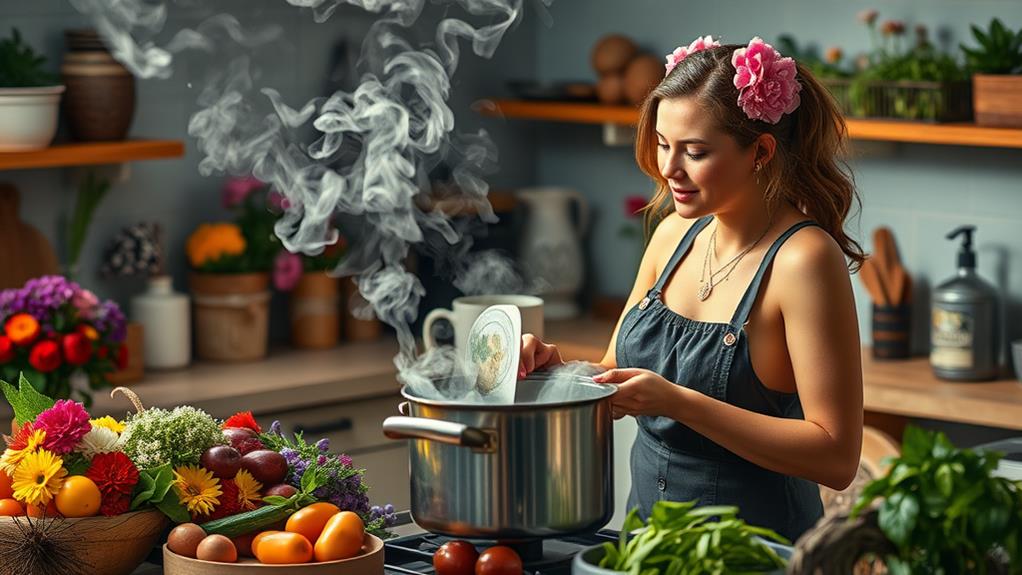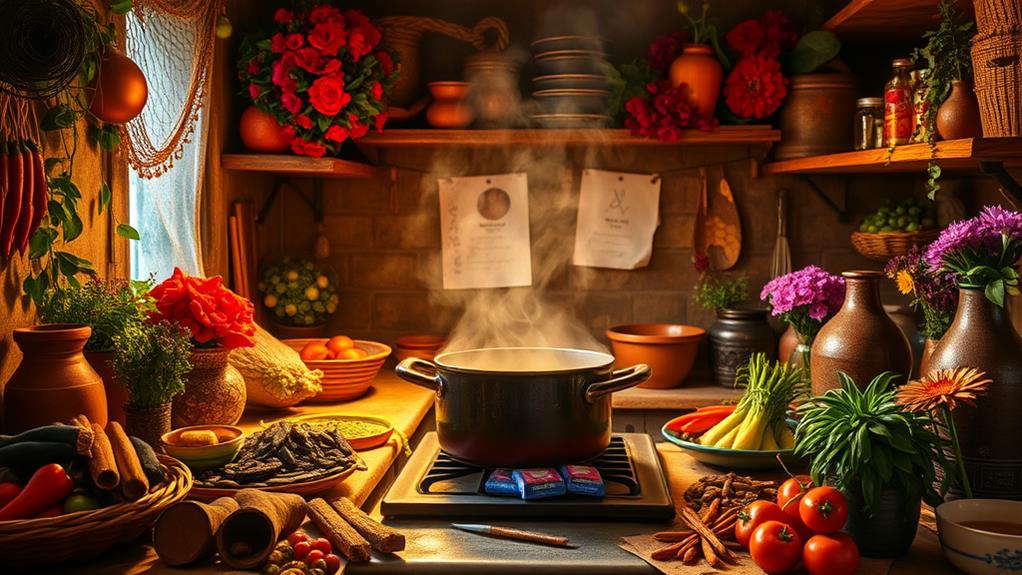"Like Water for Chocolate" captivates you with its magical realism and rich culinary imagery. The story charts Tita's emotional journey as she navigates love, family duty, and societal expectations in late 1800s Mexico. Through cooking, Tita expresses her passion and defies oppressive traditions, illustrating themes of empowerment and sacrifice. The novel's structure pairs recipes with emotional events, enhancing its depth. Critics have mixed feelings about character dynamics, but the cultural impact remains undeniable. You'll find this tale resonates deeply with themes of woman's struggle and identity, encouraging you to explore its layers further.
Cultural Significance of the Film
"Like Water for Chocolate" stands out as the first major Mexican film to be widely released in the U.S., a milestone that reshaped the landscape of Mexican cultural representation in cinema.
This film celebrates the richness of Mexican culture, immersing you in its vibrant traditions through food, music, and familial bonds. Through the lens of female empowerment and self-expression, the narrative uses magical realism to weave personal and cultural histories, making each dish a medium for emotional expression.
The film's portrayal of love and sacrifice resonates deeply, as it critiques societal expectations, particularly regarding women's roles.
You see how Tita's struggle for empowerment unfolds against the backdrop of family traditions. Every scene reflects the complexities of love and the weight of cultural heritage, urging you to contemplate the impact these traditions have on individual lives.
Plot Summary and Key Themes
In "Like Water for Chocolate," you witness Tita's emotional journey as she channels her feelings into her cooking, creating dishes that profoundly affect those around her.
The conflict between her deep love for Pedro and her family's oppressive traditions highlights the struggle many face between personal desires and familial obligations.
This dynamic mirrors the complexities of marriage, where societal expectations often challenge individual autonomy, much like the restrictions Tita faces in expressing her love.
Through Tita's culinary creations, the story reveals how food serves as a powerful medium for expressing love and maneuvering through the complexities of tradition, akin to the intricate balance between love and duty found in marital relationships the complexities of marriage.
Emotional Journey Through Cooking
Tita's kitchen becomes a vibrant canvas where her emotions blend with each dish she prepares, intricately weaving her life's story into the flavors and aromas. Throughout her emotional journey, cooking serves as Tita's outlet, allowing her to express the love she feels for Pedro, despite his marriage to her sister Rosaura. Each recipe reflects her unfulfilled desires and sacrifices, illustrating the deep connection between her heart and her culinary creations.
The elements of magical realism amplify Tita's cooking, as her feelings infuse each dish, leading to profound reactions from those who consume it. When Tita cooks, joy, sorrow, and longing spill into her creations, transforming meals into powerful expressions of her inner world. This enchanting aspect of cooking becomes a means of rebellion against her oppressive family tradition, enforced by her mother, Mama Elena.
Tita's journey embodies themes of feminine empowerment and resilience as she navigates the challenges posed by societal norms. Through her passion for cooking, she seeks to reclaim her identity and assert her individuality, making her love story not just about romance, but about personal liberation and self-discovery.
Love Vs. Family Tradition
Conflict permeates the narrative of "Like Water for Chocolate," as Tita grapples with the weight of family tradition that dictates her life choices. Forbidden to marry her true love, Pedro, Tita's struggle highlights the tension between love and duty. Mama Elena, her domineering mother, enforces the harsh family tradition that demands Tita care for her until her death, stifling her desires and happiness.
Tita's emotional journey unfolds through her cooking, where her feelings seep into the dishes she prepares. This magical realism turns her meals into tools of rebellion, evoking powerful reactions from those who consume them. When Tita cooks with love, her food ignites passion and longing, symbolizing her unfulfilled relationship with Pedro. Each dish becomes a vessel for her emotions, illustrating the transformative power of food.
The narrative emphasizes the conflict between individual desires and societal expectations, showing how Tita's love for Pedro remains unfulfilled due to the oppressive family traditions imposed by Mama Elena.
Ultimately, Tita's journey reflects the struggle to balance love and obligation, underscoring the importance of personal happiness in the face of familial duty.
Character Analysis and Dynamics

In "Like Water for Chocolate," you'll see Tita's emotional journey unfold as she battles her family's oppressive traditions, much like the resilience demonstrated by women facing adversities in inspiring narratives.
Pedro's conflicted loyalties complicate their love, making you question the true cost of duty and desire.
Meanwhile, Mama Elena's harsh influence looms over Tita, shaping her struggles and fueling her resilience, a demonstration of the transformative power of overcoming challenges.
Stories serve as beacons for others facing similar struggles.
Tita's Emotional Journey
Throughout the narrative, you witness Tita transform from a confined daughter into a woman who embraces her passions and desires. Tita's emotional connection to cooking becomes her lifeline, allowing her to express herself amid the suffocating family traditions enforced by Mama Elena. Each dish she prepares is infused with her feelings, impacting everyone who tastes her food, making her culinary artistry a profound form of communication.
The oppressive grip of Mama Elena highlights Tita's struggle between personal desires and familial obligations. This conflict drives her emotional journey, as she learns to navigate the complexities of love and duty.
Tita's relationship with her sisters adds another layer to her evolution—Rosaura embodies traditional expectations, while Gertrudis represents a more liberated spirit. Through these dynamics, Tita begins to understand the possibilities of feminine empowerment.
As Tita gains confidence and asserts her identity, she shifts from a passive victim to a symbol of strength. By reclaiming her voice through her cooking, Tita not only challenges the constraints of her upbringing but also carves out her own path toward love and fulfillment.
This transformation is a reflection of the resilience of the human spirit.
Pedro's Conflicted Loyalties
As Tita navigates her emotional journey toward self-discovery, Pedro's struggles with his loyalties become increasingly apparent. Introduced as Tita's love interest, Pedro marries her sister Rosaura due to familial obligations, creating a love triangle that complicates Tita's path to fulfillment. His marriage highlights the internal conflict between his love for Tita and the weight of societal expectations.
Pedro's indecision and perceived weakness frustrate both Tita and the audience, as he remains physically close yet emotionally unavailable. His continued expressions of love for Tita, even while bound to Rosaura, further entangle his loyalties and intensify the tension within their family dynamics.
Each interaction between Pedro and Tita is charged with unfulfilled desire, showcasing the depth of their connection despite the barriers imposed by marriage and duty.
Ultimately, Pedro embodies the struggle between societal expectations and personal desires, reflecting broader themes of love and sacrifice in the narrative. His conflicting loyalties not only shape his character but also greatly impact Tita's emotional journey, as she grapples with love, loss, and the quest for her own identity amidst the complicated web of relationships.
Mama Elena's Oppressive Influence
Mama Elena serves as the embodiment of oppressive familial traditions that stifle Tita's desires and dreams. Her strict adherence to traditional customs dictates that Tita must sacrifice her happiness for the sake of familial duty, particularly the obligation to care for her mother. This authoritarian control leads to significant emotional turmoil for Tita, leaving her feeling trapped and powerless in a world where her love for Pedro is forbidden.
Mama Elena's cruelty becomes evident through her manipulative tactics, which not only undermine Tita's identity but also dictate the dynamics within their family. Tita's struggles for love and self-expression are continuously overshadowed by Mama Elena's ghostly presence, symbolizing the lasting impact of those oppressive traditions even after her death.
The character of Mama Elena encapsulates the societal expectations placed on women during that time, highlighting the conflict between personal happiness and familial obligations. In her relentless enforcement of these customs, Mama Elena ultimately becomes an obstacle to female empowerment, forcing Tita to navigate a world where her desires are constantly suppressed.
Tita's journey toward liberation is a poignant response to Mama Elena's oppressive influence.
Cinematic Techniques and Visuals
In "Like Water for Chocolate," the cinematography immerses you in the lush beauty of the Mexican countryside, enhancing the film's magical realism. The vibrant colors and stunning visuals during food preparation scenes elevate your sensory experience, making cooking an enchanting element of the narrative.
The interplay of food and emotion resonates deeply, much like the themes of spirituality and faith in survival found in Pi's survival journey. Here are four notable cinematic techniques you'll appreciate:
- Rich Color Palette: The film employs a vibrant color scheme that complements its themes of passion and emotional turmoil.
- Lighting: Thoughtful lighting creates a fable-like atmosphere, blending reality and fantasy seamlessly.
- Visual Presentation of Food: The erotic moments linked to food consumption showcase exquisite dishes, expressing the characters' desires visually.
- Unique Narrative Structure: The interplay of reality and fantasy keeps you engaged, with unexpected twists that enhance your connection to the story.
Together, these elements create a mesmerizing cinematic experience that captures the essence of the characters' journeys.
As you watch, you'll find yourself drawn deeper into their world, where food becomes both a source of love and a means of expressing unfulfilled desires.
Audience Reception and Critique

Despite its enchanting visuals and cultural richness, audience reception of "Like Water for Chocolate" has been mixed. Many viewers found themselves deeply emotionally engaged, particularly with the film's exploration of Mexican culture and familial dynamics. The portrayal of food and cooking evokes strong sensory responses, which serve as a crucial part of the narrative's magical realism. Additionally, themes of resilience amidst adversity resonate with audiences, reminding them of the strength found in love and connection during challenging times, much like Liesel's spirit in the face of evil.
However, some criticism arose regarding character depth, with certain audiences feeling that the relationship between Tita and Pedro lacked the emotional resonance found in the original novel.
While the film is celebrated for its cultural significance in Mexican cinema, often recommended alongside the book for a fuller understanding, some viewers describe it as melodramatic. They liken its emotional beats to those of a soap opera, suggesting that this may detract from the overall experience.
This mixed audience reception highlights a tension between appreciation for the film's artistry and critique of its emotional execution. Ultimately, "Like Water for Chocolate" remains a polarizing piece, inviting viewers to either embrace or question its dramatic storytelling and character portrayals.
Overview of the Novel
"Like Water for Chocolate," penned by Laura Esquivel, immerses readers in late 1800s Mexico, intertwining love, family, and tradition through the life of Tita. As the youngest daughter in a traditional Mexican family, Tita faces the burden of caring for her domineering mother, Mama Elena, which tragically keeps her from marrying her true love, Pedro.
The oppressive family dynamics and cultural expectations parallel the struggles faced by characters in other narratives, such as those seen in immigrant experiences depicted in "A Tree Grows in Brooklyn."
The novel's structure is enchanting, divided into twelve monthly installments, each paired with a recipe that reflects Tita's experiences and emotions. Each recipe serves as a metaphor, enriching the narrative and showcasing the power of food in expressing love and longing.
Here are four key elements that make this novel stand out:
- Magical Realism: Tita's cooking has enchanting effects on those who eat it, influencing their feelings and actions.
- Love and Sacrifice: Tita's unfulfilled love story drives the plot, highlighting her struggles against family expectations.
- Family Dynamics: The oppressive influence of tradition shapes Tita's choices and relationships.
- Empowerment Through Cooking: Tita's recipes symbolize her resistance and personal growth amidst familial constraints.
This rich tapestry of themes and experiences makes "Like Water for Chocolate" a unique culinary romance.
Themes and Symbolism Explored

Food serves as a powerful conduit for exploring the themes and symbolism in "Like Water for Chocolate." Tita's journey grapples with the tension between familial duty and personal desire, illustrating her struggle to honor her mother's wishes while yearning for her own happiness.
Each chapter opens with a recipe, symbolizing how cooking allows Tita to express her emotions and influence those around her. Through her culinary creations, you witness the magical realism that permeates the narrative, as Tita's dishes evoke profound emotional responses, connecting her feelings directly to the food she prepares. This reflects the importance of personal growth and resilience, as Tita learns to embrace her identity through her cooking.
The symbolism of heat plays a significant role, representing passion, conflict, and transformation. In Tita's kitchen, her emotions literally come to life, showcasing how cooking reflects her inner turmoil and desires.
Additionally, the story explores feminine empowerment, highlighting Tita's resilience against the oppressive expectations of traditional gender roles within her family. As you investigate deeper into Tita's world, you realize that her cooking becomes an act of defiance, allowing her to reclaim her identity and assert her autonomy in a society that seeks to confine her.
Author's Impact and Legacy
Laura Esquivel's debut novel, "Like Water for Chocolate," consistently captivates readers with its rich narrative and profound themes, solidifying her impact on Latin American literature. Through its unique blend of magical realism and culinary art, Esquivel challenges traditional perceptions of women's roles, weaving together love, family, and tradition in a way that resonates deeply.
Her exploration of cultural identity and the intersection of personal and historical narratives mirrors themes found in works like the triumph of the human spirit from Louis Zamperini's survival story.
Here are four key aspects of her impact and legacy:
- Cultural Significance: Esquivel's work inspires a renewed interest in Mexican culinary traditions and storytelling, connecting readers to their cultural roots.
- Influence on Women's Literature: Her vivid portrayal of female experiences has paved the way for more diverse voices in literature, highlighting women's struggles and triumphs.
- Operatic Writing Style: The emotional depth and imagery in her prose engage readers, making Tita's journey unforgettable.
- Adaptations and Recognition: The novel's success led to film and theater adaptations, further amplifying its themes of love and tradition.
Laura Esquivel remains a monumental figure, her work continuing to inspire and challenge readers around the globe.
Conclusion
In "Like Water for Chocolate," you find a rich tapestry woven from love, tradition, and the bittersweet essence of life. Just as Tita's emotions transform her cooking, your own experiences flavor the world around you. The film and novel invite you to savor each moment, reminding you that passion, like water, can nourish or overwhelm. As you reflect on Tita's journey, you realize that every meal becomes a story, and every story, a recipe for understanding the heart.



